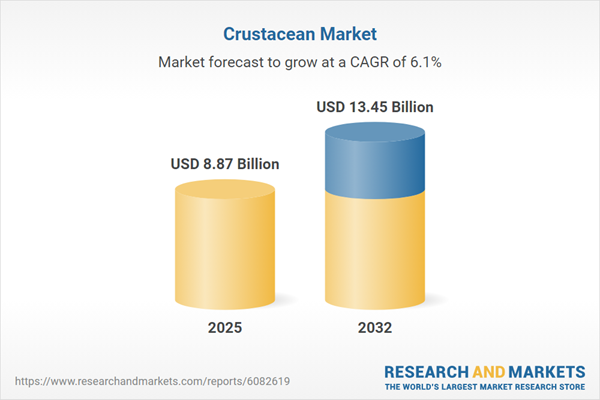Speak directly to the analyst to clarify any post sales queries you may have.
The global crustacean market is evolving as regulatory landscapes, consumer expectations, and production technologies advance. Senior decision-makers need reliable intelligence to steer growth initiatives and outperform shifting sector dynamics.
Market Snapshot: Global Crustacean Market Size and Growth Trajectory
The global crustacean market expanded from USD 8.37 billion in 2024 to USD 8.87 billion in 2025, and is projected to reach USD 13.45 billion by 2032 at a CAGR of 6.10%. Strong market momentum results from evolving health preferences among consumers, adaptable consumption patterns, and rising investment in streamlined, modern supply chains. Environmental concerns and regulatory developments increasingly influence the pursuit of sustainable and value-driven product categories, spurring demand across both established and fast-growing economies.
Scope & Segmentation of the Global Crustacean Market
This industry report offers in-depth segmentation and actionable context, enabling leaders to identify growth levers and chart effective entry strategies for the global crustacean market.
- Species: Crab, lobster, prawn, and shrimp segments help direct product diversification and highlight categories with high market traction.
- Product Form: Analysis includes canned (condensed and regular), fresh (chilled and live), frozen (block, flash-frozen, individually quick frozen), and processed (marinated, ready-to-eat) offerings, assisting businesses in shaping optimal portfolios.
- Source: Farmed versus wild-caught supply is mapped to support risk assessment, sourcing strategy, and cost management decisions.
- Distribution Channel: Coverage examines foodservice (such as restaurants and hotels), the expanding online channel, retail (including specialty and supermarkets), and wholesale distribution, equipping leaders to enhance channel presence and reach.
- End Use: Household and institutional consumption patterns are outlined to underpin product positioning and anticipate volume requirements across customer segments.
- Region: The market is segmented by Americas (North America, Latin America), Europe, Middle East & Africa, and Asia-Pacific, ensuring clarity on region-specific regulatory factors and localized demand drivers.
- Leading Companies Profiled: Profiles of Charoen Pokphand Foods Public Company Limited, Thai Union Group, Maruha Nichiro Corporation, Nippon Suisan Kaisha, Dongwon Industries, Pescanova, Austevoll Seafood ASA, Royal Greenland, High Liner Foods, and Clearwater Seafoods support competitive positioning and partnership exploration.
Key Takeaways for Senior Decision-Makers
- Stricter regulatory frameworks worldwide are prompting companies to implement transparent sourcing procedures and advanced quality assurance to foster differentiation and maintain compliance.
- Adoption of technology, such as blockchain for product traceability and advanced aquaculture systems, enhances supply chain monitoring and operational productivity.
- Heightened consumer preference for sustainably certified, convenience-oriented products creates opportunities for value-added and premium crustacean lines.
- Investments in digital commerce and omnichannel strategies enable broader access to both retail and institutional buyers, improving flexibility and market adaptation.
- Collaborations among global corporations and local producers encourage rapid deployment of disease management and feed innovations, expanding coverage through integrated value chains.
Tariff Impact: Navigating the US 2025 Tariff Landscape
Recent United States tariff changes for 2025 are shaping sourcing and supply chain decisions in the crustacean market. Importers are mitigating duty rate increases by diversifying origins and recalibrating product portfolios. Domestic aquaculture ventures are leveraging new trade protections to expand production capacities and update technologies. Industry associations continue to seek specific tariff exemptions to stabilize supply continuity, underscoring the value of agile trade and policy engagement among senior leaders.
Research Methodology & Data Sources
This analysis blends structured interviews with sector stakeholders and onsite observations with comprehensive reviews of regulatory records, industry studies, and academic publications. Data triangulation, rigorous statistical modeling, and expert peer review uphold accuracy, reliability, and alignment with industry standards.
Why This Report Matters for the Crustacean Market
- Enables data-driven decisions by presenting critical insights into changing market conditions, technology utilization, and compliance demands.
- Equips executives with frameworks to refine supply chains, expand product portfolios, and address complex regulatory environments.
- Highlights strategic innovation, regional growth trends, and emerging buyer segments, helping businesses pinpoint investment prospects and sharpen their competitive stance.
Conclusion
This comprehensive report arms sector leaders with the strategic intelligence necessary to navigate evolving regulatory, technological, and consumer challenges, positioning organizations to secure sustainable growth opportunities in the global crustacean market.
Table of Contents
3. Executive Summary
4. Market Overview
7. Cumulative Impact of Artificial Intelligence 2025
Companies Mentioned
The companies profiled in this Crustacean market report include:- Charoen Pokphand Foods Public Company Limited
- Thai Union Group Public Company Limited
- Maruha Nichiro Corporation
- Nippon Suisan Kaisha, Ltd.
- Dongwon Industries Co., Ltd.
- Pescanova, S.A.
- Austevoll Seafood ASA
- Royal Greenland A/S
- High Liner Foods Inc.
- Clearwater Seafoods Limited Partnership
Table Information
| Report Attribute | Details |
|---|---|
| No. of Pages | 197 |
| Published | November 2025 |
| Forecast Period | 2025 - 2032 |
| Estimated Market Value ( USD | $ 8.87 Billion |
| Forecasted Market Value ( USD | $ 13.45 Billion |
| Compound Annual Growth Rate | 6.1% |
| Regions Covered | Global |
| No. of Companies Mentioned | 11 |







![Aquaculture Market Size and Forecast, Global and Regional Share, Trend, and Growth Opportunity Analysis Report Coverage: By Product Type [Fish, Aquatic Plants, Crustaceans, Mollusca, and Others] and Culture Environment - Product Image](http://www.researchandmarkets.com/product_images/11667/11667003_60px_jpg/aquaculture_market.jpg)

